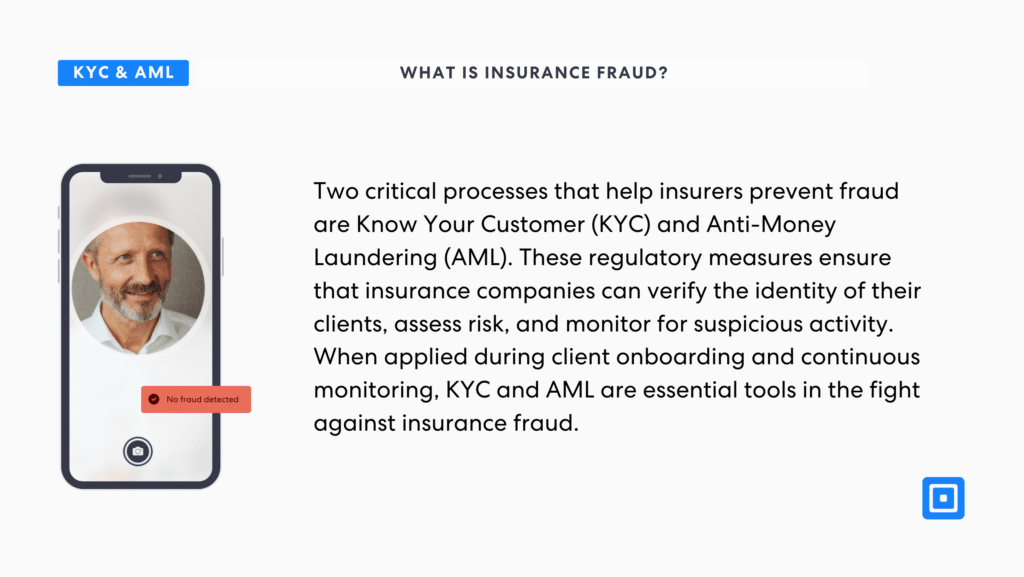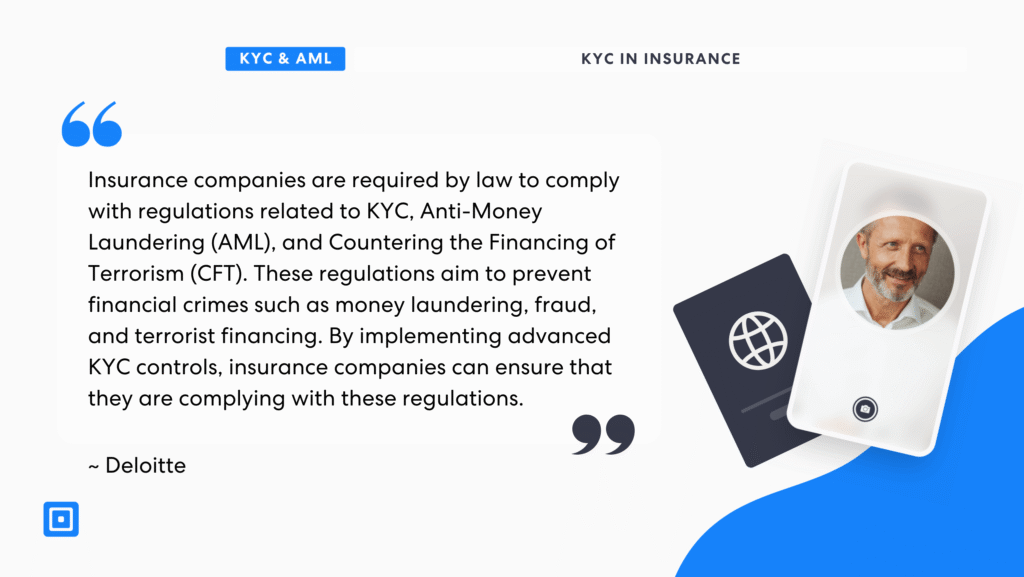Maintaining the integrity of operations and minimizing risk is crucial within the insurance sector. One of the most effective ways for insurance companies to protect themselves and their clients from insurance fraud, money laundering, and other illicit activities is through Know Your Customer (KYC) and Anti-Money Laundering (AML) measures. KYC in insurance is vital for customer identification, ongoing monitoring for suspicious activity, and ensuring accurate account information is maintained. These regulatory frameworks are essential in ensuring the legitimacy of clients, reducing financial risks, safeguarding the industry’s reputation as well as maintaining compliance with national and international regulations.
Introduction to KYC
The Know Your Customer (KYC) process verifies the identity of customers and assesses their risk profile to prevent money laundering, terrorism financing, and other financial crimes. Businesses can flag potential clients that may pose a risk to the organisation, whether that is because they have been featured in adverse media, or whether they are committing identity fraud. However, beyond the risk of fraud, insurance companies must, as dictated by law, comply with KYC and AML regulations, hence partnering with a trusted KYC provider is critical.
Insurance companies are required by law to comply with regulations related to KYC, Anti-Money Laundering (AML), and Countering the Financing of Terrorism (CFT).
Deloitte underlines the importance of KYC and AML for insurance businesses, stating, “Insurance companies are required by law to comply with regulations related to KYC, Anti-Money Laundering (AML), and Countering the Financing of Terrorism (CFT). These regulations aim to prevent financial crimes such as money laundering, fraud, and terrorist financing. By implementing advanced KYC controls, insurance companies can ensure that they are complying with these regulations.”
Furthermore, by thoroughly vetting customers, insurers can identify high-risk individuals and prevent fraudulent claims, which can lead to higher insurance premiums for honest customers. This process helps in safeguarding the financial integrity of the insurance sector and ensures that insurers are not inadvertently facilitating financial crimes.

What is KYC in Insurance?
KYC in insurance begins with gathering and confirming key information about clients to ensure that the insurer is dealing with legitimate individuals or businesses. Ensuring that clients are properly identified and their backgrounds are thoroughly reviewed reduces the risk of identity fraud, which has undergone a stark increase with the rise of AI tools and deepfakes.
Confirming the account holder’s address through various forms of identification is crucial. Documents must clearly display the account holder’s address, and certain types of proof, such as utility bills and online bank statements, have specific acceptance criteria. A biometric identity check should also be carried out, as this can accurately verify biometric data and provide a liveness score, ensuring that prospective clients match the identities presented on their documents.
Depending on the requirements of the firm, additional checks can be added, such as AML screening including adverse media checks and PEP screening. These checks help determine whether a potential client is involved in financial crime, has been featured in negative news coverage, or is a politically exposed person (PEP) who may present a higher risk of corruption or bribery. Integrating these screenings into the KYC process allows insurers to make informed decisions about onboarding clients and managing risk appropriately.
After onboarding the client, ongoing due diligence is essential. KYC is not a one-time task but a continuous process. Client information should be periodically reviewed and updated, especially when there are changes in policy ownership, claims behavior, or regulatory guidelines. Real-time monitoring systems can flag unusual transactions or behavior patterns that deviate from a client’s risk profile, prompting further investigation.
KYC Requirements for Insurance Companies
Insurance companies must conduct Customer Due Diligence (CDD) to verify a customer’s identity and evaluate their risk profile for any suspicious account activity. For customers deemed to be at higher risk, Enhanced Due Diligence (EDD) is employed to provide a more in-depth analysis of their background and financial activities. …This might include gathering additional documentation, conducting detailed source-of-funds checks, and performing more frequent monitoring of transactions. EDD is particularly important for clients with complex ownership structures, links to high-risk jurisdictions, or those flagged in sanctions or PEP screenings. For more on Enhanced Due Diligence, read “Navigating the World of Enhanced Due Diligence.”
Technologies Behind KYC
The technologies behind KYC have evolved significantly, incorporating advanced tools like Optical Character Recognition (OCR), digital transformation, and artificial intelligence (AI) to enhance the accuracy and efficiency of the process. These technologies enable insurance companies to automate KYC processes, using machine learning algorithms to identify potential fraud and reduce the risk of false claims.
The use of PAD Level 2 Liveness Detection technology drastically reduces cases of identity fraud, helping businesses identify clients who may be involved in financial crime. This technology ensures that the individual presenting their identification is physically present and not using photos, videos, or deepfake technology to impersonate someone else. By verifying that a person is live and interacting in real time with the authentication system, insurers can more effectively block fraudulent attempts before they even begin. For more on Liveness Detection, read “Deepfakes vs. Biometric Liveness Detection.”
Furthermore, AI-driven risk scoring allows insurers to evaluate the likelihood of a customer engaging in suspicious activities based on their historical behavior and other data points. These risk models are continually updated as the system learns from new data, ensuring that the insurer stays ahead of emerging threats. By automating these processes, insurers can quickly identify high-risk customers, flag suspicious activities in real-time, and adjust their risk models based on patterns and trends.
The Role of AML in Insurance
Anti-Money Laundering (AML) refers to a set of procedures, laws, and regulations that insurance companies follow to prevent money laundering and other financial crimes. While KYC focuses on verifying the identity of clients, AML goes further by monitoring clients’ transactions and behaviors to detect suspicious or illicit activity.
AML systems are particularly important in the insurance industry because they help to identify and prevent the use of insurance products for illegal activities, such as money laundering, fraud, or financing terrorism. Just as KYC is vital for onboarding new clients, AML plays an ongoing role in ensuring that clients continue to meet compliance standards throughout the life of their policies.
How KYC and AML Benefit Insurance Organizations
Insurance organizations face a multitude of risks, and the financial and reputational consequences of fraud or money laundering can be severe. By implementing robust KYC and AML frameworks, insurers can safeguard themselves from a variety of potential risks. Let’s dive into all of the benefits obtained by implementing advanced AML and KYC.
1. Preventing Fraud
Fraudulent claims are a significant concern for insurance companies, leading to financial losses, higher premiums for customers, and reputational damage. KYC processes help to identify potential fraudsters by verifying the identity of clients before coverage is provided. If a fraudulent applicant is attempting to obtain coverage using false or misleading information, KYC procedures can detect inconsistencies or discrepancies in their documentation. Insurance fraudsters engage in various activities such as false reporting of theft for vehicles, misrepresentation of health conditions for health insurance claims, and other fraudulent schemes to deceive insurance companies.
AML protocols help insurance companies to monitor clients for any signs of money laundering or suspicious activities that may indicate fraudulent behavior. By detecting irregular transactions or behavior patterns, insurers can intervene before fraud occurs, minimizing financial losses. Fraud investigations can lead to criminal convictions, emphasizing the serious legal consequences of submitting false or misleading insurance claims.
2. Enhancing Compliance
Insurance companies are required by law to comply with various regulations related to fraud prevention and financial crimes. Both KYC and AML are critical components of regulatory compliance, particularly in jurisdictions with strict anti-money laundering and anti-fraud laws. The regulatory landscape mandates that financial institutions adhere to stringent customer requirements, ensuring compliance with KYC obligations. Failure to implement these measures can result in hefty fines, legal penalties, and reputational damage.

KYC ensures that insurance companies know who their clients are and that their business activities are legitimate. AML, on the other hand, helps to detect ongoing illegal activity and ensures that insurance companies are not unknowingly facilitating money laundering or other illicit financial activities. Diligence processes are crucial in managing risks associated with underwriting insurance policies, as they involve enhanced scrutiny of high-risk customers through more frequent KYC checks.
3. Reducing Risk
Risk management is a core aspect of the insurance industry. KYC and AML provide insurers with the tools to assess and mitigate risk. By verifying the identity and background of clients, insurers can better assess the risk they pose and determine whether they are likely to engage in fraudulent or illegal behavior.
For example, individuals with a history of fraudulent claims or businesses with unstable financial histories may be considered high-risk clients. Through KYC, insurers can identify these risks early on and either deny coverage or take additional precautions to minimize potential exposure. Identifying high-risk customers through thorough KYC checks allows insurers to implement enhanced due diligence processes, conducting more frequent evaluations to better manage underwriting risks.
AML systems help insurers monitor clients over time, ensuring that any suspicious activity, such as sudden changes in financial behavior or large, unexplained claims, is flagged and investigated. Continuous monitoring reduces the risk of unknowingly providing coverage to individuals or businesses involved in money laundering, terrorism financing, or other illegal activities.
4. Improving Customer Trust
In today’s highly regulated environment, customers expect insurance companies to take the necessary steps to protect their data and ensure their safety. KYC and AML procedures demonstrate that insurers are taking appropriate measures to protect against fraud and financial crime, which can help build trust with clients.
When clients know that their insurance company has a rigorous KYC and AML process in place, they are more likely to feel confident in the security and legitimacy of the coverage they are purchasing. Understanding the customer relationship is crucial in developing risk profiles to comply with regulatory standards and detect suspicious activities. Additionally, customer-based risk management plays a significant role in tailoring premiums and investment recommendations based on the customer’s profile. This trust can lead to stronger customer relationships, better customer retention rates, and improved brand reputation.
5. Detecting and Preventing Money Laundering
Money laundering is a major global issue, and insurance companies can unknowingly become channels for illicit financial activities. The insurance industry, with its large transactions and long-term policies, is particularly vulnerable to being exploited for money laundering purposes. Regulatory compliance in relation to financial transactions is crucial for promoting transparency and preventing financial crimes.
AML processes are essential for detecting and preventing money laundering within the insurance sector. By monitoring transactions and identifying unusual behavior, insurance companies can flag suspicious activity, report it to the relevant authorities, and avoid being complicit in criminal activities. For example, large or frequent payments from unknown or high-risk sources may indicate money laundering, prompting the insurer to investigate further. National and local governments recognize insurance fraud as a serious crime, resulting in measures aimed at punishment and prevention.
6. Facilitating Business Expansion and Partnerships
Insurance organizations that have robust KYC and AML processes in place are more attractive partners for other financial institutions, regulatory bodies, and international markets. When expanding into new regions or forming partnerships with other financial organizations, demonstrating strong KYC and AML compliance can enhance an insurer’s reputation and credibility. Identifying beneficial owners in business partnerships is crucial to ensure compliance and mitigate risks associated with corporate structures. Additionally, verifying the identities of existing customers is essential in fraud prevention efforts.
In some jurisdictions, compliance with KYC and AML regulations is a prerequisite for conducting business. By ensuring that these processes are properly implemented, insurers can expand into new markets and collaborate with other businesses more seamlessly.
Challenges of Implementing KYC
Implementing KYC can be a complex and resource-intensive task for insurance companies. Ensuring compliance with regulations requires significant resources and operational efficiency. The risk-based approach to KYC necessitates that insurance companies identify and assess risk factors associated with customers, which can be both time-consuming and costly.
The use of different AML risk classes and KYC procedures adds to the complexity, requiring insurers to navigate a myriad of regulatory requirements. Balancing the need for stringent KYC processes with the need to provide a seamless customer experience is another challenge, especially in the digital age where customer expectations are high.
Regulatory bodies like the Federal Register provide guidance on KYC regulations, but insurance companies must stay vigilant and up-to-date with changing regulations and guidelines to ensure compliance. This vigilance is essential to prevent financial crimes, including identity theft and terrorism financing, and to maintain the integrity and trustworthiness of the insurance industry.
Fortify Your KYC and AML Infrastructure
KYC and AML are not just regulatory requirements, they are vital tools for protecting insurance organizations from fraud, money laundering, and reputational harm. By implementing thorough KYC and AML processes, insurance companies can verify the legitimacy of their clients, assess risk, prevent financial crimes, and ensure regulatory compliance. These practices not only safeguard the financial integrity of insurance organizations but also build trust with clients, improve customer retention, and position insurers for long-term success in an increasingly complex and regulated environment.
For more information on how to fortify your business with cutting-edge KYC and AML, get in touch with our expert compliance team.




